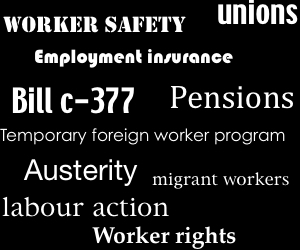Unions are greedy. Unions destroy the economy by prompting companies to move overseas and driving up public debt with their exorbitant salary demands. Unions just want to take as much of the pie as they can get for their members, leaving less for everyone else. So the story goes, if you’re a crass free market fundamentalist or, say, a Sun News pundit.
But that narrative is completely backwards, according to most labour rights advocates. And increasingly, they’re being backed up by empirical research that suggests strong unions are essential for evenly spreading the benefits of economic growth across all income classes. Some of that research is summed up in a report released this week by the Canadian Foundation for Labour rights titled “How the Ability of Labour Unions to Reduce Income Inequality and Influence Public Policy has been affected by Regressive Labour Laws.”
Here, gleaned from that report, are ten interesting facts that shed light on the relationships between unionization, income inequality and labour rights in Canada:
1. A 2002 review by the World Bank of more than a thousand studies of the effects of unions on national economies concluded that “high rates of unionization lead to greater income equality, lower unemployment and inflation, higher productivity and speedier adjustments to economic shocks.”
2. In Canada, the proportion of workers represented by unions nearly doubled from 28 per cent in 1951 to 42 per cent in 1984, but has been on the decline ever since, falling to 31 per cent by 2011.
3. In recent years, income inequality is growing at a faster rate in Canada than in the U.S.
4. Since the lowest point in the recent recession (2009 to 2011), real average hourly wages in Canada have declined by 0.6 per cent.
5. According to the Bank of Canada, Canadians have reached a personal debt ratio of 166 percent, meaning that for every $1 earned, $1.66 is owed. (That’s higher than the debt ratio of Americans at the height of the U.S. housing bubble in 2007.)
6. Since 1982, the federal and provincial governments have amended labour laws more than 64 times in ways that restrict unions’ ability to organize.
7. In the 1970s, all provinces used the simple card check system, whereby an employer must legally recognize a union if the majority of workers sign membership cards. Since then, B.C., Alberta, Saskatchewan, Ontario and Nova Scotia have moved to requiring that workplaces also hold a vote before the union will be legally recognized.
8. Studies have found that the additional requirement of holding a vote decreases the success of union organizing drives by between 9 and 20 per cent.
9. In the past three decades, Canadian provinces and the federal government have passed more laws restricting labour rights than during any other period in the history of labour relations in Canada. They’ve passed 45 laws that suspended the collective bargaining rights of workers and imposed wage freezes or rollbacks.
10. A 2012 study by five UBC economists concluded that roughly 15 per cent of the growth in income inequality in Canada throughout the 1980s and 1990s was directly linked to falling rates of unionization.
Lori Theresa Waller is rabble.ca‘s labour reporter.



